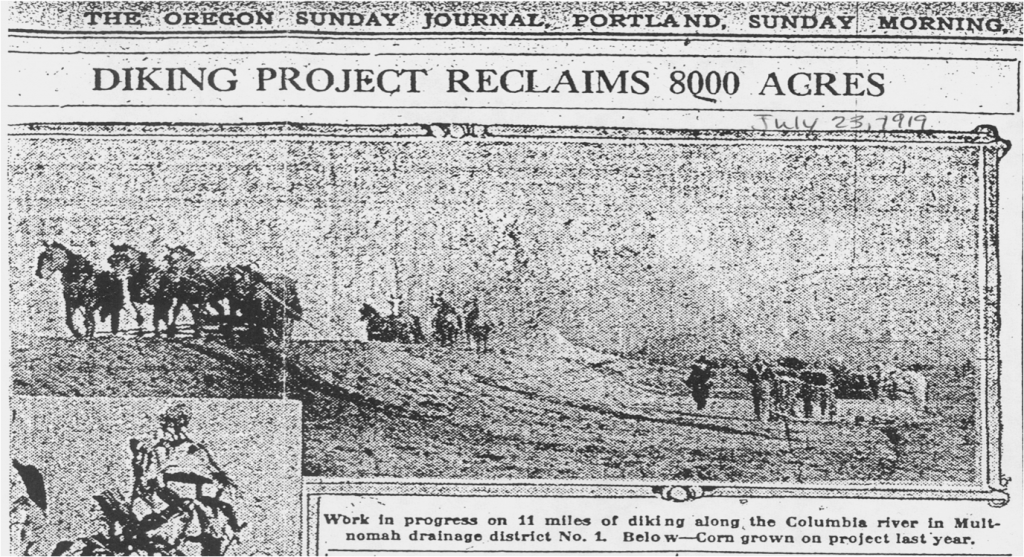
WORKING UNDER CENTURY OLD STRUCTURES INCREASE OUR RISK
In 1917, four independent drainage districts were set up to drain the land for agricultural purposes. They took on the responsibility of operating and maintaining the 27-mile levee system along the Columbia River in Multnomah County after it was built by the US Army Corps of Engineers in the late 1930s. Although they’ve done the best they can, the drainage districts were not designed to manage large urban flood safety infrastructure and operating under the same legal framework put in place over a century ago, has led to a number of challenges. including:
- it's highly inefficient
four separate drainage districts are not needed to manage one infrastructure system - it's unsustainablethe drainage districts were not set up to manage a large urban flood safety system and have not been able to meet shifting federal safety standards
- it's inequitable
the current funding structure is very limited and does not account for all services delivered or benefit received - it's outdated
the management of the infrastructure is separated from the health of the natural landscape around it - it's exclusive
the way leadership is elected is antiquated and leaves people out of the process

A more efficient, modern, and equitable management and funding structure is needed
After several years of research and discussion, the LRC partners worked with local state legislators to introduce legislation to reform and modernize the way the local levee system is managed and to make a more robust set of financial tools available to support the system going forward. The State Legislature almost unanimously passed the legislation and it was signed into law by the Governor in late July.
This new structure has been designed to:
- Meet long-term flood safety needs and shifting federal standards;
- Create a less fragmented framework for management and decision-making
- Provide for a more equitable distribution of costs based on services and benefits received;
- Allow for improved environmental stewardship along the levees and drainageways, which is currently prohibited under the drainage district structure; and
- Create a more democratic and transparent selection process for board members in which significantly more people have a voice.
Hear more about the new management structure from our convener, Jules Bailey, during his testimony to the Senate Committee on Environment & Natural Resources on February 19, 2019:
What's Next
This new district will have two different board configurations at different times. First, an initial 17-member board will be responsible for organizing the district and setting up a sustainable revenue structure. Once the revenue structure is in place, the initial board can call for the dissolution of the four existing drainage districts. At that point, the initial board will begin to transition to a permanent structure of 9 board members who are responsible for the ongoing oversight of the district.
The initial 17-member board will include:
- one representative each from each of the five cities in the region - the City of Portland, Gresham, Fairview, Troutdale, and Wood Village, appointed by their respective City Councils
- one representative of Multnomah County, appointed by the County Board of Commissioners
- one representative of Metro, appointed by the Metro Council
- one representative of the Port of Portland, appointed by the Port Commission
- one representative of each of the four local drainage districts that currently manage the flood safety infrastructure, appointed by their respective Boards of Supervisors
- One resident of the managed floodplain, appointed by the Governor
- One business owner or representative of a business from within the managed floodplain, appointed by the Governor
- One nonprofit from within the managed floodplain, appointed by the Governor
- One representative of an environmental conservation organization, appointed by the Governor
- One representative of an environmental justice organization, appointed by the Governor
The permanent board will include 9 members, each serving four-year terms, including:
- 5 elected members include 4 individuals who are either residents, business owners, or the designee of a business owner from within the managed floodplain; and 1 resident of urban Multnomah County
- one representative of the Port of Portland, appointed by the Governor
- one individual with expertise or interest in flood safety, appointed by the Governor
- one individual with expertise or interest in environmental conservation, appointed by the Governor
- one individual with expertise or interest in environmental justice, appointed by the Governor
Explore the authorizing legislation:
Find out more about:
what else would be possible with improved funding and oversight structures
Our partners in the Columbia Slough Watershed
Find out how you can help